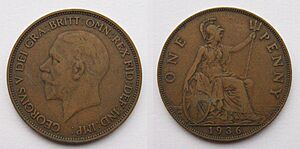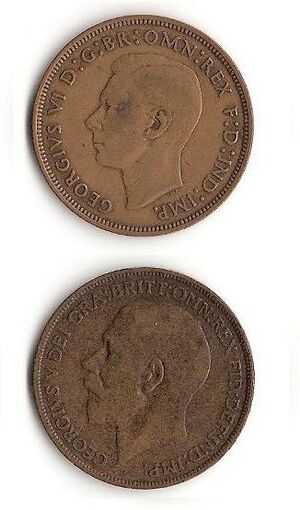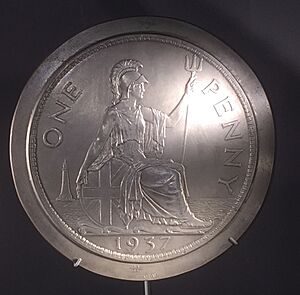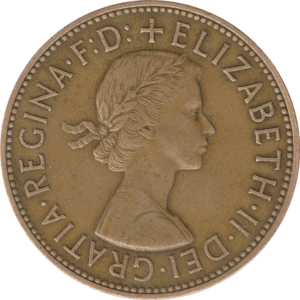History of the British penny (1901–1970) facts for kids
The British penny was a large coin used in Britain for a very long time, starting around the year 700! This article focuses on the pennies made from 1901 until they stopped being used after 1970. Before 1971, a British pound was worth 240 pennies.
On the "heads" side (called the obverse), the bronze penny showed the king or queen who was ruling at the time. The "tails" side (called the reverse) featured Britannia, a symbol of Britain, sitting with a shield, a trident (a three-pronged spear), and a helmet. This design was created by Leonard Charles Wyon, based on an older drawing by his father, William Wyon. These pennies were also used in British colonies and dominions (countries that were part of the British Empire) that didn't make their own coins.
In 1895, the Britannia design was slightly changed. After Queen Victoria died in 1901, a new design for Edward VII was made for the "heads" side. This new penny came out in 1902 and was used until Edward died in 1910.
A new penny showing George V came out in 1911. This design stayed in use, with a few small changes, until George V died in 1936. No new pennies were made for everyday use in 1933 because there were already enough. However, at least seven were made that year, mostly to be placed under new buildings or in museums. Today, these 1933 pennies are very valuable!
Edward VIII was king for a very short time. Only one special sample coin, called a pattern coin, was made for him, dated 1937. That same year, a new design showing George VI was used. From 1941 to 1943, during World War II, pennies were only made for the colonies. These coins were all dated 1940, which was the last year they were made in the United Kingdom. After the war, people started using pennies less. Many of the 1950 and 1951 pennies were sent to Bermuda. Later, British coin collectors bought many of them back because they were quite rare.
Even though they weren't needed for everyday use in 1953, pennies with Elizabeth II's picture were made for special coin sets sold to the public. Only one 1954 penny was made, just for testing at the Mint. By 1961, many new pennies were needed again.
In the 1960s, officials planned to change to a new money system (decimalisation). They didn't want to keep the large bronze penny, as its value had gone down because of inflation. The last pennies made for everyday use were dated 1967. A final set of special collector coins was dated 1970. The old pennies quickly went out of use after Decimal Day on February 15, 1971. They didn't have an exact value in the new money system. Shops would only accept them in groups worth six old pence. The old penny officially stopped being money on August 31, 1971.
Contents
Edward VII Pennies (1902–1910)
After Queen Victoria died in 1901, the Royal Mint (where coins are made) planned new coins for her son, Edward VII. People at the Mint wanted to change the coins as little as possible. So, they decided to keep the "tails" side of the penny, halfpenny, and farthing the same. This design had already been updated in 1895.
The Engraver of the Royal Mint, George William de Saulles, had removed the lighthouse and sailing ship that used to be next to Britannia on the "tails" side. De Saulles was then asked to create the new picture of King Edward for the "heads" side. The Mint kept making coins with Victoria's picture, dated 1901, until the new King's coins were ready in May 1902.
King Edward posed for de Saulles twice in 1901. De Saulles also used a drawing of the King by artist Emil Fuchs. The King's head on the coin was made quite flat, so it would be easy for the Royal Mint to make. However, the head was quite large, which sometimes caused a faint outline of the "heads" side to show through on the "tails" side. This was called "ghosting." On December 10, 1901, it was announced that the new bronze coins would be used starting January 1, 1902.
Edward's pennies were made from the same metal mix as the last Victorian ones: 95% copper, 4% tin, and 1% zinc. Like all bronze pennies from 1860 to 1970, they weighed about 9.4 grams and were about 30.8 millimeters wide. The King's head faces right on these coins. The words around his head say EDWARDVS VII DEI GRA BRITT OMN REX FID DEF IND IMP (which means "Edward VII, by the Grace of God, King of all the Britains, Defender of the Faith, Emperor of India"). The "tails" side still showed Britannia, with the words ONE PENNY and the date. This design stayed mostly the same until the penny was stopped after 1970. Pennies with Edward's picture were made from 1902 to 1910. There are two slightly different versions of the 1902 penny, known as "high tide" and "low tide," because the water level around Britannia was changed.
George V Pennies (1911–1936)
After de Saulles died in 1903, the job of Engraver was removed. When George V became king in 1910, a competition was held to design his coins. Bertram Mackennal won this competition. The King liked his work so much that he was given special honors. The words around the King's left-facing head say GEORGIVS V DEI GRA BRITT OMN REX FID DEF IND IMP. The "tails" side design stayed mostly the same. These new bronze coins were announced on November 28, 1910, and started being used on January 1, 1911.
Besides the Royal Mint, some pennies were also made at the Heaton Mint in Birmingham in 1912, 1918, and 1919. These coins have a small "H" next to the date. In 1918 and 1919, some were made by the Kings Norton Metal Co. Ltd, also in Birmingham, and have a "KN" mark. Both companies also provided metal blanks to the Royal Mint to be made into pennies. This was because there was a very high demand for small change, first due to a new law in 1911, and then because of the war years. Also, vending machines, which became popular, needed a lot of pennies.
To get rid of old, worn-out pennies, the Royal Mint started taking them back from banks and post offices. From 1922, pennies made between 1860 and 1894 could be returned, even if they were very worn. Older copper pennies (made before 1860) had already been officially stopped as money after 1869.
King George's pennies were made with the same metal mix until 1922. After that, the mix was changed slightly to 95.5% copper, 3% tin, and 1.5% zinc. They still weighed about 9.4 grams and were about 30.8 millimeters wide. This new mix was a bit softer, which helped reduce the "ghosting" problem. No pennies were made in 1923, 1924, or 1925 because there wasn't enough demand. In 1928, the King's portrait was made a bit smaller, which helped fix the "ghosting" issue. The words around his head stayed the same, and Britannia remained on the "tails" side, though that design was slightly changed in 1922.
By the end of George V's reign in 1936, the bronze penny was seen as heavy and clumsy. It was the heaviest bronze coin used in Europe. Its weight caused problems for businesses. For example, the London bus company received 6,000 tons of pennies, halfpennies, and farthings each year! Making the penny smaller was not practical because it would take too long to remake the 3 billion pennies already in use. Also, many vending machines would need to be changed. So, in 1937, a new, twelve-sided brass threepence coin was introduced. This was because three pennies or halfpennies were heavy, and the old silver threepenny bit was considered too small.
The Rare 1933 Penny
The Mint didn't need to make any pennies for everyday use in 1933 because they had plenty. However, it was a tradition for the King to place a set of coins from the current year under the foundation stone of important new buildings. So, the Mint made three 1933 pennies for this purpose. They also made one for their own museum, one for the British Museum, and at least two others. This made the 1933 penny extremely rare. Many people hoped to find one in their pocket change, making it one of Britain's most famous rare coins.
The exact number made wasn't written down, but only seven are known to exist today. One of these 1933 pennies sold in 2016 for about US$193,875 (around £149,364 at that time). The known 1933 pennies are in the Royal Mint Museum, the British Museum, and one is still under the Senate House of the University of London (placed there by King George in 1933). Three are now owned by private collectors. One penny was stolen, and its location is unknown. This missing coin was placed under the Church of St Cross, Middleton, Leeds, in 1933. It was stolen in August 1970 during church repairs. To prevent more thefts, the Bishop of Ripon ordered another 1933 penny, placed under St Mary's Church, Hawksworth Wood, Leeds, to be dug up and sold. As far as we know, the penny under Senate House is still there.
Four special sample coins, called pattern coins, were also made for 1933 by sculptor André Lavrillier. These were not approved. One of these sold at auction in 2016 for £72,000.
Edward VIII Pattern (1937)
No coins of King Edward VIII (who reigned in 1936) were officially released for use. However, there is one penny dated 1937. It's a sample coin, made for the King to approve. He probably would have approved it around the time he gave up his throne. The "heads" side, designed by Humphrey Paget, shows the King facing left. He thought this was his best side and wanted to break the tradition of alternating the direction the monarch faces on coins. The words on the "heads" side are EDWARDVS VIII D G BR OMN REX F D IND IMP.
When the Royal Mint's committee thought about new designs for King Edward's coins, they didn't want a new look for the penny. Instead, they wanted the lighthouse and ship (seen on older pennies before 1895) to return. They wanted a modern warship instead of the old sailing ship. But officials felt this looked too aggressive during a sensitive international time. So, the ship was not put back, but the lighthouse was added to Edward's sample pennies and stayed on the penny until it was stopped after 1970.
George VI Pennies (1937–1952)
King George VI's new coins were officially released on March 18, 1937. The usual Britannia design was kept for the penny. However, the halfpenny and farthing got their own new designs.
George VI's pennies (made from 1937 to 1952) show his left-facing head, also by Paget. The words around his head changed. From 1937 to 1948, they said GEORGIVS VI D G BR OMN REX F D IND IMP. From 1949 onwards, they changed to GEORGIVS VI D G BR OMN REX FIDEI DEF. This removed the Latin for "Emperor of India" after India became independent. Pennies were made for everyday use from 1937–1940, and 1944–1951. However, during 1941–1943, pennies were only made for the colonies, using the 1940 design. These mostly went to Gibraltar and the British West Indies.
Some experts believe that pennies weren't made for Britain during the war because there were too many. But others say it was to save copper for making weapons. Starting in 1942, the metal mix for pennies changed because tin was hard to get during the war. So, pennies from then until 1945 were 97% copper, 0.5% tin, and 2.5% zinc. These coins would tarnish (change color) differently. They were treated with a chemical to make them darker. This chemical was also used on some 1934 and 1935 pennies, and again in 1946, to make them darker and stop people from collecting the new shiny pennies. The old metal mix was brought back in 1945. But in 1959, the Mint went back to the wartime mix for the rest of the penny's life.
By the late 1940s, people in Britain were using pennies less. This was probably because the lighter, more convenient brass threepence coin was popular. It weighed much less than the same value in bronze pennies. After the war, there was a high demand for pennies until January 1949, when it suddenly dropped. In May 1949, the Royal Mint stopped making them. Officials thought this drop was permanent because inflation meant the penny could buy very little, and many vending machines no longer accepted it. The Royal Mint started taking back extra copper coins from banks in 1951 to melt them down. By the end of the 1950s, about £1.2 million worth of pennies had been removed from use.
The 1950 and 1951 pennies were only made for the colonies, as Britain didn't need them. In 1956, all the 1950 pennies and most of the 1951 pennies were sent to Bermuda. Both years had very few pennies made compared to earlier George VI pennies. Coin dealers from London went to Bermuda and offered a lot of money for these rare coins. Collecting coins by date became popular in the early 1960s. The 1951 penny became very popular, with many claims about how valuable it would become. Only one 1952 penny is known to exist, made by the Royal Mint.
Elizabeth II and the End of the Penny (1953–1970)
The series of pennies that were worth 1/240 of a pound ended with the coins made for Queen Elizabeth II before Decimal Day. The "tails" side designs for the penny and other bronze coins didn't change much for the new Queen. Her coins were officially released on November 25, 1952, and started being used on January 1, 1953. No pennies were made for everyday use in 1953. This was because there were already many pennies in circulation. However, special coin sets, including the penny, were made for the Queen's Coronation that year. The "heads" side of these coins showed a right-facing picture of the Queen by Mary Gillick. The words around her head said ELIZABETH II DEI GRA BRITT OMN REGINA F D. These were not meant for everyday use, but since the sets were sold for only a little more than their face value, many were later broken up and spent. In all later pennies, the words changed to ELIZABETH II DEI GRATIA REGINA F D. The Latin words for "Queen of all the Britains" were removed because the British Commonwealth now included some republics (countries without a monarch).
Only one 1954 penny is known. It was made for testing at the Royal Mint and was supposed to be melted down, but it was found in circulation. By the late 1950s, the cost of the metal meant that every bronze coin was made at a loss. The Mint hoped to make the coins smaller. The farthing coin was stopped at the end of 1960, which helped clear the way for changes. It wasn't until 1961 that more pennies were needed. They were made in very large numbers every year until the last pennies for everyday use, dated 1967.
The old bronze penny was planned to be removed when decimal currency was introduced in the 1960s. Pennies continued to be made after 1967, but they still had the 1967 date. The metal mix of 97% copper, 0.5% tin, and 2.5% zinc was used again for the pennies in the 1960s. Finally, special collector coins dated 1970 were made to say goodbye to a coin that had been used in Britain for 1200 years. The long-standing picture of Britannia from the penny was later used on the new decimal fifty-pence coin.
The Decimal Currency Board thought people would need up to 18 months to get used to the new money system after Decimal Day, February 15, 1971. But the "old penny" quickly disappeared from use. It officially stopped being legal money after August 31, 1971. It was the last of the three bronze coins to go, as the halfpenny had been removed in 1969. With decimalisation, the new penny was worth 1/100 of a pound, which was 2.4 times the value of the old penny.
Penny Mintages
This list shows how many pennies were made each year, including those from other mints. "H" means Heaton Mint; "KN" means King's Norton.
- 1901 ~ 22,205,568
- 1902 ~ 26,976,768
- 1903 ~ 21,415,296
- 1904 ~ 12,913,152
- 1905 ~ 17,783,808
- 1906 ~ 37,989,504
- 1907 ~ 47,322,240
- 1908 ~ 31,506,048
- 1909 ~ 19,617,024
- 1910 ~ 29,549,184
- 1911 ~ 23,079,168
- 1912 ~ 48,306,048
- 1912H ~ 16,800,000
- 1913 ~ 65,497,872
- 1914 ~ 50,820,997
- 1915 ~ 47,310,807
- 1916 ~ 86,411,165
- 1917 ~ 107,905,436
- 1918 ~ 84,227,372
- 1918H/1918KN ~ 3,580,800
- 1919 ~ 113,761,090
- 1919H/1919KN ~ 5,290,600
- 1920 ~ 124,693,485
- 1921 ~ 129,717,693
- 1922 ~ 22,205,568
- 1926 ~ 4,498,519
- 1927 ~ 60,989,561
- 1928 ~ 50,178,000
- 1929 ~ 49,132,800
- 1930 ~ 29,097,600
- 1931 ~ 19,843,200
- 1932 ~ 8,277,600
- 1933 ~ 7 known
- 1934 ~ 13,965,600
- 1935 ~ 56,070,000
- 1936 ~ 154,296,000
- 1937 ~ 109,032,000 (plus 26,402 proof coins)
- 1938 ~ 121,560,000
- 1939 ~ 55,560,000
- 1940 ~ 42,284,400
- 1944 ~ 42,600,000
- 1945 ~ 79,531,200
- 1946 ~ 66,855,600
- 1947 ~ 52,220,400
- 1948 ~ 63,961,200
- 1949 ~ 14,324,400
- 1950 ~ 240,000 (plus 17,513 proof coins)
- 1951 ~ 120,000 (plus 20,000 proof coins)
- 1952 ~ 1 known
- 1953 ~ 1,308,400 (plus 40,000 proof coins)
- 1954 ~ 1 known
- 1961 ~ 48,313,400
- 1962 ~ 157,588,600
- 1963 ~ 119,733,600
- 1964 ~ 153,294,000
- 1965 ~ 121,310,400
- 1966 ~ 165,739,200
- 1967 ~ 654,564,000
- 1970 ~ 750,000 (souvenir sets only)
|






